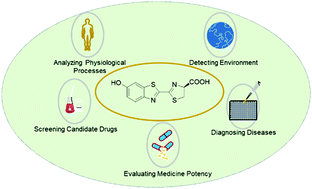Constructing firefly luciferin bioluminescence probes for in vivo imaging
Abstract
Bioluminescence imaging (BLI) is a widely applied visual approach for real-time detecting many physiological and pathological processes in a variety of biological systems. Based on the caging strategy, lots of bioluminescent probes have been well developed. While the targets react with recognizable groups, caged luciferins liberate luciferase substrates, which react with luciferase generating a bioluminescent response. Among the various bioluminescent systems, the most widely utilized bioluminescent system is the firefly luciferin system. The H and carboxylic acid of luciferin are critically caged sites. The introduced self-immolative linker extends the applications of probes. Firefly luciferin system probes have been successfully applied for analyzing physiological processes, monitoring the environment, diagnosing diseases, screening candidate drugs, and evaluating the therapeutic effect. Here, we systematically review the general design strategies of firefly luciferin bioluminescence probes and their applications. Bioluminescence probes provide a new approach for facilitating investigation in a diverse range of fields. It inspires us to explore more robust light emission luciferin and novel design strategies to develop bioluminescent probes.



 Please wait while we load your content...
Please wait while we load your content...